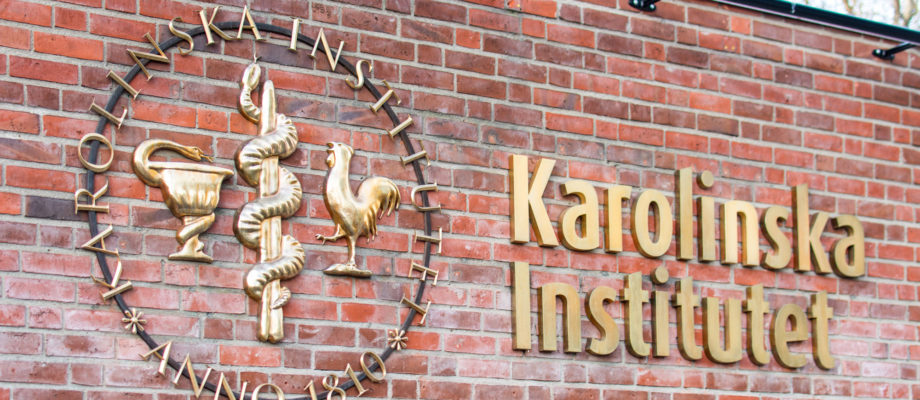CONSTRUCTION PLANS. According to the plans, the building for the Faculty of Science planned for the Medicinareberget campus will begin to be built in around two years’ time. There will be upheaval, with ground works, laying of foundations and erecting the framework all impacting neighboring buildings and business. But there are lessons to be learned from others’ experiences. Freelance journalist Madeleine Salomon met head vet Mats Spångberg at Karolinska Institutet, who shared his work on protecting animals against stress.
Over the course of just over a year, the Citybanan rail and the new commuter rail line were built in Stockholm. Blasting and digging was an almost daily event, directly under the Astrid Fagraeus lab at Karolinska Institutet in Solna. The laboratory has the most common types of animals such as mice, rats, rabbits and guinea pigs, as well as pigs and monkeys. All sensitive to stress. The staff were therefore very worried how the animals would be affected by the building works.
Testing may come to nothing

“If the animals are stressed, our testing may come to nothing, with huge costs as a consequence. But with good communication with the building manager, we managed to solve the situation without major issues,” says Mats Spångberg, head vet at the Astrid Fagraeus laboratory, and explains that even long before the work began, a consultant came to the lab and explained the type of disruption that the works might cause.
“We then contacted the Swedish Transport Administration (Trafikverket) and discussed different options for how we could solve the problems of the animals being affected as little as possible.”
Sensitive mouse breeding
“Mouse breeding in particular is very affected by disruption, and different breeds are sensitive to different degrees. This can lead to the fact that our testing gives wildly varying results and needs to be redone. Which, of course, costs. The first thing we thought about was moving the mice to a commercial breeder. Of course, transportation is also stressful for the animals. But we considered that any distress would be fleeting. However, the problem was that no breeder could take on so many mice at once.”
Mats Spångberg explains that they instead decided to come up with a management plan. The plan included hiring an acoustics consultant who estimated the vibrations that would occur during construction.

Reaction to vibrations
“Mice do react more strongly to vibrations than to noise. The solution was to place vibration-dampening plates on the floor where we could put the rack. We first tested on a small scale before deciding which solution to go for.
Once the work was underway, we saw that there was no noticeable drop in the breeding. We also think that the animals got used to the disruption, by beginning the blasting some distance away and gradually getting closer.”
Mats Spångberg explains that they also laid down vibration-dampening plates under the cages. This means that nothing is noticeable when trains now go underneath the building.
Major immune system
But it was not just the mice who could have reacted negatively to the construction. The laboratory also conducts vaccine testing on monkeys, for illnesses such as HIV, tuberculosis and malaria.
“Absolutely, monkeys must not be affected by stress. It can disrupt their immune system, which would destroy all our testing results.” The lab also conducts neurological research, which requires that the brains of the animals remain unaffected.
“Differently to mice, monkeys react strongly to sudden noises. So it’s not enough for them to just have vibration-dampening plates. To solve the problem, we once again brought in an acoustic consultant. What we then did was test two groups of monkeys where we simulated noise and blasting. We placed loudspeakers in two different rooms where we had monkeys. In one of the rooms, the monkeys received a warning signal, in the form of a piano melody, before they simulated the blasting. We then looked at the monkeys’ behavior and measured the cortisol levels in their excrement, from both groups. We could see that the warning signal helped the monkeys to get used to the noise.”
Sent a text message
Mats Spångberg explains that after the experiment, the construction manager for Citybanan permanently installed a warning signal for the duration of the works. Ten seconds before any blasting would occur, a signal was sent via SMS.
“This worked well,” he says, and points out that they had both technical and financial help from the construction manager for everything that needed to be done during the building period. “We also explained that if our animal testing were to be impacted, it could have meant hundreds of millions of kronor, and we were absolutely clear that we would send any compensation claim to the Swedish Transport Administration.
Of course this has at times been difficult for everyone involved. I don’t want to hide that fact. But, the fears we had before construction began were never actually realized.”
Open attitude is important
Mats Spångberg says that for everything to go as smoothly as possible, it is essential to have good communication and an open attitude.
“You have to understand that of course the work needs to be done. Throughout the entire period, we had weekly meetings with the Swedish Transport Administration where we could voice our concerns and get answers to our questions. We also let them look at the animals, so they could gain understanding of what our work was about. And we were invited to look at the tunnel to see how the construction was progressing,” says Mats.
TEXT AND PORTRAIT PHOTO: MADELEINE SALOMON/FREELANCE JOURNALIST












